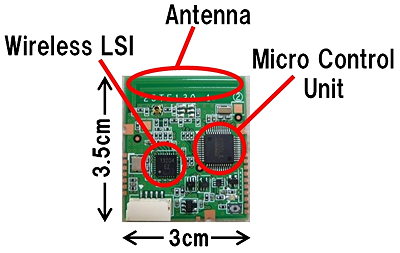- Home » News » Technology News
Multi-mode wireless sensor system can run for 20 years

Panasonic in Japan has developed a low-power wireless communication technology for M2M (machine-to-machine) sensor networks, which will allow devices using different communications standards to communicate with each other without human intervention, and operate for 20 years on one battery.
Panasonic says that the technology will allow engineers to design and develop tiny wireless modules that can operate autonomously for many years. It will make it easier to connect disparate devices and accelerate the spread of wireless sensor networks.
The technology is based on a chip that can simultaneously detect multiple wireless communication standards, which may differ from one country to another or in different applications. The system integrates multiple communication modes by sharing software with the same functions and reducing the amount of signal processing that needs to be performed.
Currently, different countries use different forms of wireless communication to connect devices to sensor networks. The new technology integrates multiple receiver circuits, enabling devices to be connected easily and stably, regardless of operating frequencies and wireless standards. The multi-mode wireless chips – which occupy an area similar to the receiving part of conventional single-mode wireless chip – can support up to three different wireless modes simultaneously.
Panasonic says the new module’s power consumption is 55% lower than its existing products, enabling a 20-year battery life (based on the example of a smart meter application which receives and transmits information every 30 seconds, and is powered by a 1,200mAh lithium-ion battery).
The reduced power consumption is achieved by controlling voltage supplies “intelligently” and by generating high-rate internal clocks from low-rate clocks to minimise circuit currents. In conventional wireless receivers, a constant voltage is used for each circuit to guarantee stable operation regardless of operating frequencies or temperatures. However, maintaining the constant voltage needs a continuous supply, which wastes energy.
Panasonic’s intelligent power supply technology controls the voltage dynamically, depending on its frequency, the temperature and process variations. This reduces current consumption – for example, the current drawn by the high-frequency oscillator circuit (which consumes the most of current) is 70% lower than Pansonic’s previous designs.

The multi-mode technology is also said to reduce the memory capacity requirement.
The technology used to shrink the size of the wireless chips reduces the sizes of coils in the oscillator circuits and eliminates the filters usually used in analogue-to-digital converters.
Panasonic holds 26 Japanese patents and 19 overseas patents related to the new wireless technology (including some that are pending). Development of the technology was supported, in part, by the Japanese Ministry of Internal Affairs and Communications.
Field tests of the technology have started at the University of Tokyo’s Research Center for Advanced Science and Technology.





